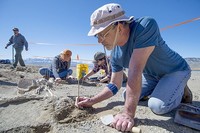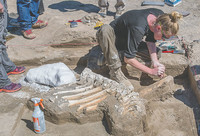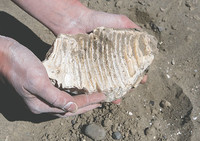Cloudy, 32° F
The thousands of years-old specimen, uncovered on Bureau of Reclamation land within the Buffalo Bill State Park west of Cody, was first secured by federal law enforcement agents and state park officials a week ago. Then, at the request of the …
This item is available in full to subscribers.
The Powell Tribune has expanded its online content. To continue reading, you will need to either log in to your subscriber account, or purchase a subscription.
If you are a current print subscriber, you can set up a free web account by clicking here.
If you already have a web account, but need to reset it, you can do so by clicking here.
If you would like to purchase a subscription click here.
Please log in to continue |
|




The discovery last week of Park County’s first mammoth remains sent federal, state and local officials scrambling.
The thousands of years-old specimen, uncovered on Bureau of Reclamation land within the Buffalo Bill State Park west of Cody, was first secured by federal law enforcement agents and state park officials a week ago. Then, at the request of the bureau, Wyoming state archaeologist and University of Wyoming adjunct professor Greg Pierce was asked to assemble a team to salvage the exposed, extremely fragile pieces of bone.
“We’re going to be collecting the remains so they don’t get ruined in any way or [have] anything bad happen to them so they are preserved,” Carlie Ronca, manager of the Wyoming Area Office of the Bureau of Reclamation, explained at a Thursday meeting in Powell, adding, “It’s big news for us and in this community.”
The remains of the Columbian mammoth were found within the Buffalo Bill Reservoir, which has been drawn down in anticipation of spring runoff from the Absaroka Range. The bones were spread out in an 80- to 100-meter area of lake bed that will soon be covered by about 30 feet of water.
Pierce’s team led experts and graduate students — several with experience with mammoth sites — as they raced to the site from Laramie and across the region to plan and execute the salvage effort.
A storm predicted for Monday pressured the group to move quickly in a task that involved hundreds of specimens — a number which grew as heavy winds exposed more bone each day. Volunteers are often invited to help with sites, but due to the speed needed in the emergency situation, Pierce opted to only use experienced individuals. However, some spectators wound up aiding the effort.
For instance, 7-year-old Toby Zierlein, a Cody elementary school student with an interest in paleontology and wildlife, alerted Bonnie Smith to an unmarked bone.
Smith, curatorial assistant at the Draper Natural History Museum and president of the Park County Archaeology Society, was one of several local experts invited to join the salvage team.
The center of attention was on a large section of a partially articulated vertebral column, complete with dorsal spines and ribs. The section was determined to be from the front of the mammoth’s back, near the neck, and included the first rib in the mammal’s rib cage. Painstaking work to measure, map and reveal the column uncovered a few surprises, but the section did not appear to be attached to the head of the specimen, Pierce said. It could be further down in the soil or in another location, he said, but it may never be recovered.
“Anything is possible, but there has been a number of studies that have looked at taphonomy and how things break down. The head is usually the first thing to break down because the head is often buried last so it’s exposed to the elements the longest,” Pierce said. (Taphonomy is “the branch of paleontology that deals with the processes of fossilization.”)
Thanks to pictures of the specimen, scientists knew they’d be dealing with a mammoth even before arriving in Park County. Larry Todd, a renowned archaeologist from Meeteetse, volunteered to assist Saturday and Sunday and helped identify remains of a Pleistocene era (ice age) horse found among the bone debris.
Due to wave action in the reservoir, everything recovered at the site is suspect. Near the large section of the mammoth’s back, scientists found a piece of what appeared to be charred bone. But they also recovered a piece of steel — a reminder that it could take years of research to determine what’s associated with the mammoth and what was deposited through the years in the original South Fork river valley, and eventually, the relatively short period under the reservoir.
“It’s standard practice for archaeological investigations to make preliminary interpretations in the field, but you put all the data together back in the lab where you can analyze evidence more closely,” said Brigid Grund, a Powell resident with a doctorate in archaeology.
“In the short time we’ve been digging here, we have no clear evidence that humans killed this mammoth or are associated with it in any way as yet,” she said.
A Columbian mammoth could reach the height of 13-feet at the shoulders and weigh as much as 6 tons. Radio-carbon dating will be performed within the next month to six weeks to determine the approximate period the specimen lived. Should the age be determined to be within the timeline of early Paleo-Indians (as long as 14,000 years ago), it is possible the site could be one of less than 20 kill sites discovered on the North American continent. Two lie in Wyoming: the La Prele site near Douglas and the Colby site near Worland, where seven individual mammoths were discovered with associated materials attributed to early man.
A smaller section of a mammoth could mean it was a transportable piece of the animal — carried from the kill site to a new spot to be consumed, Pierce said. But he reiterated how little is known about the site due to the small amount of time scientists have had to view artifacts; early speculation isn’t offered without warnings that anything is possible and very few things are known at this point of the discovery.
Assistant state archaeologist Marcia Peterson led the salvage effort of the back section, guiding several scientists with experience in archaeology and paleontology. That included Grund, who recently received her doctorate in archaeology at the University of Wyoming, and Adam Guinard, a grad student at UW who’s from Powell. Originally hoping to have the section encased in plaster and removed by Saturday, the team continued to work on the area through Sunday, knowing precipitation could undo much of their work on the extremely fragile remnants.
The team was able to get the section cast, but it took until Monday morning to wrap up the salvage operation: They removed the section just before rain started.
With no time to sort through the evidence on site and even tiny pieces (called microdebitage) important, all was collected for fear evidence would be washed away by a large storm or as the water level is raised. All materials removed from the central location were screened, using reservoir water to separate possible evidence from mud, sand and clay. Even the smallest piece could be a clue to the demise of the mammoth. Pierce said they would use finer screens than usual to collect evidence.
“Just think if you have a stone knife and you’re cutting with it and a tiny little piece flakes off,” he said. “You’re not going to see it here, but we’ll see it once we take it back to the lab.”
Marieka Arksey, collections manager at the University of Wyoming Archaeological Repository, led the effort to catalog remains deposited in a bone debris field, located some 80 meters from the main section. By Saturday, she began to piece together field specimen No. 85 with plastic consolidant. Prone in the dirt with a strong wind blowing sand in her eyes, and the hot sun burning exposed skin, Arksey worked patiently with what were essentially puzzle pieces.
The specimen was fragile and began to fall into several pieces while she worked to preserve and catalog the large artifact. Applying consolidants with a tiny brush — similar to one used to apply fingernail polish — she worked patiently, despite hundreds of eroding specimen awaiting her attention.
Field specimen No. 85 wasn’t the first catalogued, but it may be the most important piece.
“This tooth was the specimen found that helped identify the species as mammoth,” Arksey said. “The vertebrate alone are hard to identify on their own. Mammoth teeth are very unique and easily identifiable.”
A crowd surrounded Arksey as she removed the piece. She patiently answered questions while she wrapped the specimen for transport back to Laramie.
“Education is an important way to help protect the site,” she said.
The archaeology team from UW covered the site with landscape screening and put down a layer of gravel and large boulders to protect it from washing away. They headed back to Laramie with the artifacts in tow and will soon begin planning for more digging next year, Pierce said.
“Now that they know it’s there, they’ll have a lot longer digging season next year,” said Nick Neylon, state park regional manager.
The Bureau of Reclamation lowered the reservoir’s levels in recent months to make room for what’s expected to be a well above-average amount of melting snow.
State park officials expect the water to cover the site soon.
“Usually the runoff doesn’t start until mid-May,” said Dan Marty, Buffalo Bill State Park ranger. “It all depends on how quickly it gets hot.”
The bureau has said some of the mammoth’s remains may have been disturbed before land managers were notified and the agency is investigating whether any materials were taken before security was set up. Ronca, the bureau’s Wyoming manager, said the fossils were found under “a little bit suspicious circumstances that [are] being investigated.”
Department of the Interior officials interviewed several witnesses last week. Removing artifacts from federal land without specific authorization can result in criminal and/or civil penalties.
“The best thing to do if you find something unusual is to take a picture and contact us,” Pierce said.
The area will remain under surveillance for the foreseeable future — at least until rising water makes the site inaccessible.
Not a lot is known about the Columbian mammoth found outside Cody. But as a team of researchers did the painstaking work of extracting as much of the specimen’s remains as they could, they gave it a nickname: “Uncle George.”
However, it’s so early in the process that even the sex of the mammoth is not yet known.
“For all we know, it could be Georgette,” said Marieka Arksey, state archaeological collections manager.
The unofficial nickname comes from a bit of Park County history, and the official name of the site, “Marquette.”
Wyoming State Archaeologist Greg Pierce headed up the team and, along with the many responsibilities of managing the site, got the privilege of naming it.
“We talked about what we should name the site before we came out,” said Pierce. “We heard about the town of Marquette that was buried under the reservoir, so we wanted to name it after the town.”
Marquette, Wyoming, was a small ranching community — settled before Cody was founded 10 miles to the east. The place drew its name from George “Uncle George” Marquette, one of the first immigrants to move to the area to farm and ranch on the South Fork river bottoms. However, the community came to an early demise when it was decided to build a dam and create what’s now known as the Buffalo Bill Reservoir.
Some preliminary observations indicate Uncle George could be a juvenile. Archaeologists on the site pointed to a lack of fusing in some joints in a large section of back and rib cage discovered half buried in the soil. The age of Uncle George may be hard to determine, but any official calculation will be released once the team has had a chance to study artifacts in the lab at the University of Wyoming Archaeological Repository located in Laramie. The depository functions jointly under the UW Department of Anthropology and the Office of the Wyoming State Archaeologist.